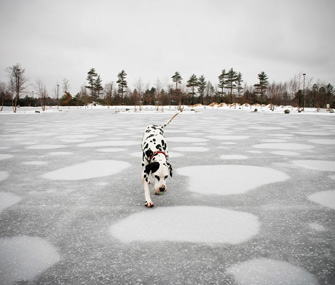How to Keep Your Dog Safe Around Ice
Published on February 10, 2014

We talked to Kara Owens, an information officer with the boat and water safety division of Minnesota’s Department of Natural Resources, to get some guidelines.
“I’m sure there are instances where animals wander off on bodies of water and they think it’s just a big field — they wouldn’t know the difference,” Owens says. She notes that many of us treat our dogs as we would our children — and that thinking of them that way around ice is a good start because they don’t know they’re in danger.
Here are four things to keep in mind.
Use a leash. “You don’t want that dog to go out there and, God forbid, they happen to fall in,” Owens says. Keeping him on a leash around water will prevent him from venturing out onto the ice in the first place.
Check the ice thickness. You need to see 4 inches of new, clear ice to assume it’s safe for walking. You can check it using a variety of tools, like an ice auger or a cordless drill (the Minnesota DNR has more details on how to do that). If temperatures have been above freezing for 24 consecutive hours, double those ice thickness recommendations. You also need to double this thickness if the ice is white. Local bait shops, resorts or police and fire departments may be able to help you with determining ice safety.
Snow makes ice less safe. Owens warns that although many people assume a recent snowfall means the ice is safer, the opposite is true. The snow cover insulates the ice, and the weight of it can push down, causing cracking.
If your dog goes out on the ice, don't follow. First call to him. If he won’t come or falls through, call 911 — don’t try to go after him. “Don’t risk your own life by going on the ice yourself,” Owens says. “The rescuers are trained in this; they know what to do.”
If you keep these things in mind, you and your pooch will be well on your way to staying safe during these cold winter months.
Read more Vetstreet pet safety articles:





